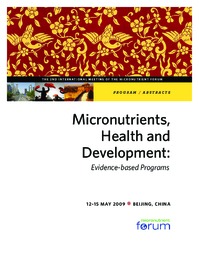Development of cassava (Manihot esculenta, L.) and orange flesh sweet potato (Ipomoea batatas, L.) products: an application for biofortified crops.
Development of cassava (Manihot esculenta, L.) and orange flesh sweet potato (Ipomoea batatas, L.) products: an application for biofortified crops.
Autoria: SILVA, E.; RANGEL, C.; ASCHERI, J.; WATANABE, E.; SILVA, J.; FUKUDA, W.; CARVALHO, J.; NUTTI, M.; SALVADOR, L.
Resumo: The objective of this study was to evaluate the possibility of the production of food products using biofortified cassava flour (CF) and orange flesh sweet potato flour (OFSP). In order to use new flours for the production of bakery and extruded products, mixtures of different proportions of these flours with wheat flour need to be evaluated to keep the quality of the product. In order to produce pastas using OFSP, the extrusion process was performed in a single screw Pastaia extruder with a fusilli matrix. Afterwards, the pasta was dried in an air circulated oven at 40°C for 1 hour. These pastas and their flours were characterized by particle size, water absorption index (WAI), water solubility index (WSI) and viscosity. In order to observe the substitution limit for the wheat flour (WF) in bakery products, levels of 10%, 15% and 20% of CF were used in breads, and 20% in cakes. These formulations were compared to a standard formulation (100% WF). It could be observed that, according to the extrusion parameters studied, the production of pastas using a biofortified raw material is feasible. The bakery products presented a darker color and a smaller final volume, when compared to the standard loaves. Changes in loaf characteristics were accentuated by the increase of the substitution level; thus, loaves with 10% of substitution were more similar to the standard. In spite of these differences, all the products produced with CF were considered as acceptable for consumption as the standard.
Ano de publicação: 2009
Tipo de publicação: Resumo em anais e proceedings
Unidade: Embrapa Hortaliças
Palavras-chave: Bakery products, Batata-doce, Biofortificação, Extrusão, Ipomoea Batatas, Mandioca, Manihot esculenta, Manihot esculenta Crantz, Nutrição, Processamento, extrusion
Observações
1 - Por padrão são exibidas publicações dos últimos 20 anos. Para encontrar publicações mais antigas, configure o filtro ano de publicação, colocando o ano a partir do qual você deseja encontrar publicações. O filtro está na coluna da esquerda na busca acima.
2 - Para ler algumas publicações da Embrapa (apenas as que estão em formato ePub), é necessário ter, no celular ou computador, um desses softwares gratuitos. Sistemas Android: Google Play Livros; IOS: iBooks; Windows e Linux: software Calibre.
Acesse outras publicações
Acesse a Base de Dados da Pesquisa Agropecuária (BDPA) para consultar o acervo completo das bibliotecas da Embrapa.

